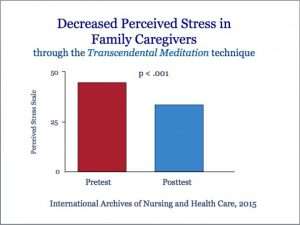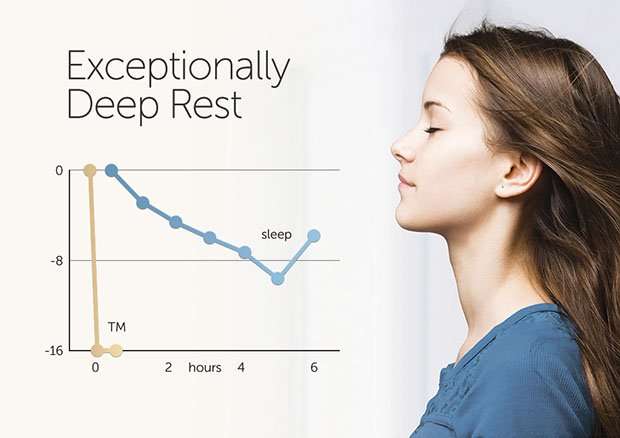People ask what is TM Meditation? It is a popular form of meditation that has been practiced by millions of people worldwide. It is a simple, natural, and effortless technique that involves the use of a mantra to help the practitioner achieve a state of deep relaxation and inner peace. It is effective in reducing stress, anxiety, and depression, improving focus and concentration, and promoting overall health and well-being.
The origins of TM Meditation or Transcendental Meditation can be traced back to the teachings of Maharishi Mahesh Yogi, an Indian saint who brought out the technique in the 1950s. Maharishi believed that through the practice of TM, individuals could achieve a state of transcendence, or a state of consciousness beyond waking, dreaming, and sleeping. He also believed that this state of consciousness could help individuals tap into their full potential and achieve their goals and aspirations.
Today, TM is practiced by people from all walks of life, including celebrities, athletes, business leaders, and politicians. It is taught by certified instructors through a one-on-one course of instruction, and practitioners are encouraged to meditate twice a day for 20 minutes each time. In the following sections, we will explore the core principles of TM, the technique itself, the benefits of TM, and the scientific research that supports its effectiveness.
Key Takeaways
-
TM is a popular form of meditation that anyone can do easily.
-
TM involves the use of a mantra to help the practitioner achieve a state of deep relaxation and inner peace.
-
TM is scientifically shown to be effective in reducing stress, anxiety, and depression, improving focus and concentration, and promoting overall health and well-being.
What is TM Transcendental Meditation: origins
Transcendental Meditation (TM) is a type of silent meditation that involves the effortless use of a mantra or sound. The regular practise of TM can produces the experience of inner peace and calmness, which can lead to improved physical and mental health.
Maharishi Mahesh Yogi and the TM Movement
Maharishi Mahesh Yogi was born in India and was trained in physics and mathematics. He became interested in meditation and studied under Swami Brahmananda Saraswati. In the mid-1950s, Maharishi began teaching a form of meditation that he called Transcendental Deep Meditation. Later, he renamed it Transcendental Meditation.
Maharishi’s teachings gained popularity in the 1960s, and he became known as the “guru to the Beatles.” He established the International Meditation Society and began training teachers to instruct others in the practice of TM. Today, the TM movement has centers all over the world and has taught millions of people how to meditate.
Historical Context
The 1950s and 1960s were a time of great change in the world. People were searching for new ways to live and new ways to find meaning in their lives. The teachings of Maharishi Mahesh Yogi and the TM movement offered a way for people to find inner peace and calmness in the midst of a chaotic world.
The popularity of TM grew as people began to see the benefits of meditation for their physical and mental health. Research has shown that TM can lower blood pressure, reduce anxiety and depression, and improve cognitive function. Today, TM is practiced by people of all ages and backgrounds, and its popularity continues to grow.
What is TM Meditation?
Transcendental Meditation (TM) is a unique form of silent effortless meditation to help the practitioner achieve a state of deep relaxation. At the heart of TM lie core principles and a philosophy that guide practitioners on their journey to self-discovery.
The TM technique is typically practiced twice a day for 20 minutes each time. During the meditation, the individual sits comfortably with their eyes closed and silently practises the technique in an effortless manner. The technique is designed to be easy to learn and practice, and is suitable for people of all ages and backgrounds.
Mantra Usage
One of the key principles of TM is the use of a mantra. A mantra is a sound or phrase that is repeated silently during meditation. The use of a mantra helps the practitioner achieve a state of deep relaxation and inner peace. The mantra used in TM is chosen specifically for each individual by a trained TM teacher and is kept secret.
The use of a mantra is central to the practice of TM. It is believed that the use of the mantra helps to quiet the mind and allow the practitioner to access a state of pure consciousness. This state is characterized by a sense of inner peace, clarity, and calm.
Effortless Transcending
Another key principle of TM is the concept of effortless transcending. Unlike other forms of meditation that require the practitioner to concentrate or focus on something, TM is designed to be easy and effortless. The practitioner simply sits comfortably with their eyes closed and begins their mantra silently.
The goal of TM is not to achieve a specific state of mind or to have a particular experience. Rather, the goal is simply to allow the mind to settle down and access a state of deep relaxation. This state of awareness has a wide range of benefits, including reduced stress and anxiety, increased creativity and productivity, and improved overall health and well-being.
Learning Meditation
Individuals who wish to learn the TM technique can do so by attending a series of meditation sessions with a certified TM teacher. During the sessions, the individual will receive personal instruction on how to practice the technique, as well as guidance on how to integrate the practice into their daily life.
The first session typically lasts for 90 minutes and includes an introduction to the technique, a discussion of its benefits, and a personal instruction on how to practice the technique. When you meet with a TM teacher for this introductory session, she will explain the mechanics of the TM technique and answer your questions, ensuring you have a clear understanding of what to expect.
Subsequent sessions typically last for 60-90 minutes and provide additional instruction and guidance on how to deepen the individual’s practice. These follow-up meetings are designed to help you refine your technique and address any questions or challenges you may encounter as you progress.
There is also a hybrid online option although the day of instruction is in person.
The TM course fee includes personal one-on-one instruction, group sessions, personal meditation tune-ups, and lifetime support from certified TM instructors. Individuals who take the course will also have access to the TM app, group meditations, and TM events.
Overall, the TM training and courses are designed to provide individuals with the tools and support they need to practice TM effectively and integrate it into their daily lives.
Benefits of TM
Transcendental Meditation (TM) is a form of meditation that has been practiced for thousands of years. Here are some of the benefits of TM:
Stress Reduction

One of the primary benefits of TM is stress reduction. Research has shown that TM can help reduce stress and anxiety, and improve overall well-being. A study published in the Journal of Alternative and Complementary Medicine found that TM was effective in reducing symptoms of anxiety and depression in college students. Another study published in the Journal of Clinical Psychology found that TM was effective in reducing symptoms of post-traumatic stress disorder (PTSD) in veterans.
Cognitive Improvements
TM has also been found to have cognitive benefits. A study published in the Journal of Cognitive Processing found that TM improved cognitive flexibility and creativity. Another study published in the Journal of Psychosomatic Research found that TM improved attention and working memory.
Health and Wellness
TM has also been found to have many health benefits. A study published in the American Journal of Hypertension found that TM was effective in reducing blood pressure in hypertensive patients. Another study published in the Journal of Alternative and Complementary Medicine found that TM was effective in reducing symptoms of irritable bowel syndrome (IBS). TM has also been found to improve sleep quality and reduce insomnia.
TM is a simple and effective way to improve mental, physical, and emotional health. Its benefits have been studied extensively and have been found to be effective in reducing stress, improving cognitive function, and promoting overall health and wellness.
How Transcendental Meditation Assists Women Dealing with Serious Illnesses, Eating Disorders, or Depression
Transcendental Meditation (TM) offers profound benefits for women facing significant health challenges. Engaging in this technique twice a day fosters a sense of inner tranquility that is often difficult to find in the outside world. Here’s how it can help:
Emotional Resilience
- Stress Reduction: TM is known for its ability to significantly reduce stress levels. Lower stress can aid in managing symptoms of illnesses and mental health conditions by promoting mental clarity and emotional stability.
- Enhanced Mood: Regular practice improves overall mood and well-being, which can be particularly beneficial for those experiencing depression or emotional turmoil associated with eating disorders.
Physical Health
- Boosted Immunity: The meditative state achieved through TM can enhance the body’s immune response. This is crucial for women battling serious illnesses, as a stronger immune system supports overall health and recovery.
- Improved Sleep: Better sleep quality is another advantage. Adequate rest is essential for the body’s healing processes and helps to manage the physical and emotional strain of chronic illness or depression.
Coping Mechanisms
- Increased Focus and Cognitive Function: TM can improve attention and clarity of thought, assisting women in better managing their daily tasks and medical treatments. This heightened focus is key for anyone juggling the complexities of a serious illness.
- Emotional Support: It provides a safe mental space for introspection and self-compassion. This is invaluable for dealing with the self-critical nature often seen in eating disorders and depression.
Community and Peer Support
- Shared Experience: Many women find comfort in the shared practice of TM, often joining groups that provide mutual support and understanding. This sense of community can be a lifeline for those feeling isolated by their conditions.
Regularly practicing TM offers women a powerful tool in their journey toward healing and balance. Whether dealing with the physical challenges of serious illnesses or the emotional hurdles of eating disorders and depression, TM provides a versatile, supportive approach to well-being.
How TM Benefits Girls and Young Women in Their Academic and Personal Lives
Transcendental Meditation (TM) offers a multitude of benefits for girls and young women, both academically and personally. By practicing TM twice daily, individuals can access a serene internal space that boosts their overall well-being and performance.
Academic Advantages
- Enhanced Focus: Regular TM practice improves concentration, making it easier for students to stay engaged with their studies.
- Reduced Stress: Meditation techniques help lower stress levels, allowing young women to approach exams and assignments with a calm mindset.
- Better Time Management: With improved focus and reduced anxiety, multi-tasking and time management become second nature, leading to higher productivity.
Personal Advantages
- Self-Esteem and Confidence: TM aids in managing the insecurities and challenges often associated with adolescence, boosting self-image and self-worth.
- Emotional Stability: Regular meditation helps in dealing with peer pressure and the fluctuating emotions that come with growing up, fostering emotional resilience.
- Health Benefits: For those facing serious health issues such as eating disorders or depression, TM can serve as an effective complementary practice, aiding recovery and offering mental clarity.
In summary, TM provides young women with essential tools to navigate both academic challenges and personal growth, leading to a more balanced and fulfilling life.
How Does Transcendental Meditation (TM) Specifically Benefit Women?
Transcendental Meditation (TM) offers a range of benefits tailored to the unique challenges and needs faced by women today.
Boosts Academic and Professional Success
Women who practice TM often see improvements in their academic and professional lives. The technique enhances focus and cognitive function, helping young women perform better in school and empowering women in their careers.
Reduces Stress and Fatigue
Daily TM practice is a powerful tool against the stress and fatigue that many women experience. By allowing the mind to settle and reset, it eliminates accumulated stress and rejuvenates energy levels, creating a sense of mental clarity and calm.
Enhances Emotional Well-being
For women dealing with the pressures of modern life—whether it’s balancing work and family, managing social expectations, or navigating personal insecurities—TM serves as a sanctuary. It helps manage the emotional ups and downs, providing a coping mechanism to deal with anxiety, depression, and even serious illnesses.
Supports Adolescents and Young Adults
Adolescence and young adulthood are critical periods for emotional and social development. TM helps young women handle peer pressure and self-image issues more effectively. It provides a stable foundation for personal growth and self-acceptance.
Promotes Holistic Health
Beyond mental and emotional benefits, TM also contributes to physical well-being. It has been associated with improved heart health, better sleep, and even helps in managing eating disorders. The practice brings a sense of balance that permeates every aspect of life.
Facilitates Multi-tasking and Focus
Given the multi-faceted roles that women often juggle, from careers to family responsibilities, TM aids in enhancing multi-tasking abilities and maintaining focus. Practicing TM twice a day helps women ‘regroup within’, making daily tasks seem less overwhelming and more manageable.
In summary, TM is a holistic approach that offers women a respite from the rollercoaster of life. Its benefits span academic, professional, emotional, and physical realms, providing a pathway for self-improvement and spiritual growth.
Scientific Research on what is TM Meditation
Transcendental Meditation, or TM, has been the subject of over 600 scientific studies over the past few decades. These studies have explored the effects of TM on various aspects of health and well-being, including stress reduction, cardiovascular health, and brain function.
What is TM Meditation: Clinical Studies
A 2021 systematic review and meta-analysis of randomized controlled trials found that TM was effective in reducing symptoms of anxiety, depression, and stress. The study also found that TM was associated with improvements in quality of life and overall well-being [1]. Another randomized controlled trial found that TM was effective in reducing blood pressure in patients with hypertension [2].
Neurological Findings
Research has also explored the neurological effects of TM. A study published in the journal Brain and Cognition found that long-term TM practitioners had increased activity in the prefrontal cortex, a part of the brain associated with attention and self-regulation [3]. Another study found that TM was associated with increased gray matter in the brain, particularly in areas related to attention and emotional regulation [4].
Overall, the scientific research on TM suggests that it may be an effective tool for reducing stress, improving cardiovascular health, and promoting overall well-being. However, further research is needed to fully understand the mechanisms behind these effects and to determine the best ways to incorporate TM into clinical practice.
[1] Sharma, H., et al. (2021). Effects of Transcendental Meditation on mental health outcomes: A systematic review and meta-analysis of randomized controlled trials. Journal of Psychiatric Research, 141, 62-71.
[2] Schneider, R. H., et al. (2012). A randomized controlled trial of stress reduction for hypertension in older African Americans. Hypertension, 60(4), 880-890.
[3] Travis, F., et al. (2010). Default mode network activation and Transcendental Meditation practice: Focused attention or automatic self-transcending? Brain and Cognition, 76(1), 105-112.
[4] Luders, E., et al. (2009). The underlying anatomical correlates of long-term meditation: Larger hippocampal and frontal volumes of gray matter. NeuroImage, 45(3), 672-678.
Certification Process for TM Teachers
TM is taught by certified instructors. All certified TM instructors have successfully completed an intensive TM Teacher Training Course. This course is designed to ensure that each instructor has a deep understanding of the TM technique and how to teach it effectively.
The certification process is rigorous and requires instructors to undergo ongoing professional courses to maintain their certification. This ensures that individuals who are learning TM are receiving instruction from highly trained and knowledgeable instructors.
Comparisons with Other Forms of Meditation
Transcendental Meditation (TM) is a popular form of meditation that has been practiced for over 50 years. While there are many different forms of meditation, TM is unique in its use of a specific mantra, or sound, to achieve a deep state of relaxation and mental clarity. Here are some comparisons with other forms of meditation:
Mindfulness Meditation
Mindfulness meditation is a form of meditation that involves focusing your attention on the present moment. It is often used as a way to reduce stress and anxiety, and to improve overall well-being. While both TM and mindfulness meditation are effective in reducing stress, they differ in their approach. TM uses a specific mantra to help the mind achieve a state of deep relaxation and mental clarity, while mindfulness meditation focuses on being present in the moment and observing thoughts and sensations without judgment.
Zen Meditation
Zen meditation, also known as Zazen, is a form of meditation that originated in Japan. It involves sitting in a specific posture and focusing your attention on your breath. Like TM, Zen meditation can be used to achieve a state of deep relaxation and mental clarity. However, Zen meditation is more focused on developing awareness and understanding of the nature of the mind and the world around us.
Overall, while there are many different forms of meditation, each with their own unique approach and benefits, TM stands out as a powerful tool for achieving deep relaxation and mental clarity. Whether you are looking to reduce stress, improve your overall well-being, or simply explore the world of meditation, TM is a great place to start.
How Does TM Compare to Other Methods in Reducing Trait Anxiety?
When evaluating the effectiveness of various anxiety-reduction techniques, it’s essential to look at the data. A comprehensive review of 146 independent studies provides illuminating insights.
Key Findings
- Twice as Effective: The Transcendental Meditation technique was found to reduce trait anxiety at twice the rate of other common methods.
- Robust Evidence: This conclusion is drawn from a meta-analysis, offering strong evidence due to its aggregation of numerous studies.
Comparison with Other Methods
Traditional methods like mindfulness meditation, cognitive-behavioral therapy (CBT), and relaxation techniques each have their benefits. However, the data suggests that Transcendental Meditation leads to more significant reductions in anxiety levels.
Here’s why:
- Simplicity: TM is often easier to practice consistently, which can lead to more sustained outcomes.
- Physiological Impact: It significantly affects the autonomic nervous system, aiding in deeper relaxation.
- Accessibility: With less stringent practice requirements, it becomes more accessible to a broader audience.
By employing TM, individuals may find a more efficient path to alleviating anxiety compared to other therapies. This makes it an attractive option for those seeking quick and lasting relief.
Local TM Centers
There are TM centers located throughout the world, where individuals can learn the technique from certified TM teachers. These centers offer personalized instruction, group meditations, and ongoing support. To find a local TM center, individuals can visit the Transcendental Meditation website.
Online Guides to find out what is TM Meditation
For those who may not have access to a local TM center, there are a variety of online resources available. The Transcendental Meditation website offers a variety of resources, including articles, videos, and an FAQ section. Additionally, there are a variety of online guides and tutorials available that can help individuals learn the technique on their own.
Overall, there are a variety of resources available for those who want to learn more about Transcendental Meditation. Whether individuals choose to learn from a certified TM teacher or use online resources, the technique can be a powerful tool for reducing stress and improving overall well-being.
Can Transcendental Meditation be self-taught or is a teacher necessary?
While there are many resources available online and in books that provide information on TM, it is recommended that individuals learn the technique from a certified TM teacher. A TM teacher can provide personalized instruction and guidance on how to practice the technique correctly, as well as answer any questions that may arise during the learning process.
Are there any risks or side effects associated with practicing Transcendental Meditation?
There are no known risks or side effects associated with practicing TM. The technique is safe and easy to learn, and can be practiced by individuals of all ages and backgrounds. However, as with any new practice, it is important to start slowly and gradually increase the amount of time spent meditating to avoid discomfort.




















Here’s a thoughtful comment you could post on the blog:
*”This was such a clear and insightful explanation of TM meditation! I appreciate how you broke down the technique and its benefits in a way that’s easy to understand, especially for beginners. I’ve always been curious about how TM differs from other meditation styles, and your article helped clarify that. Have you found any specific challenges people face when starting TM, and do you have any tips for overcoming them? Looking forward to more content like this!”*
Let me know if you’d like it tweaked! 😊